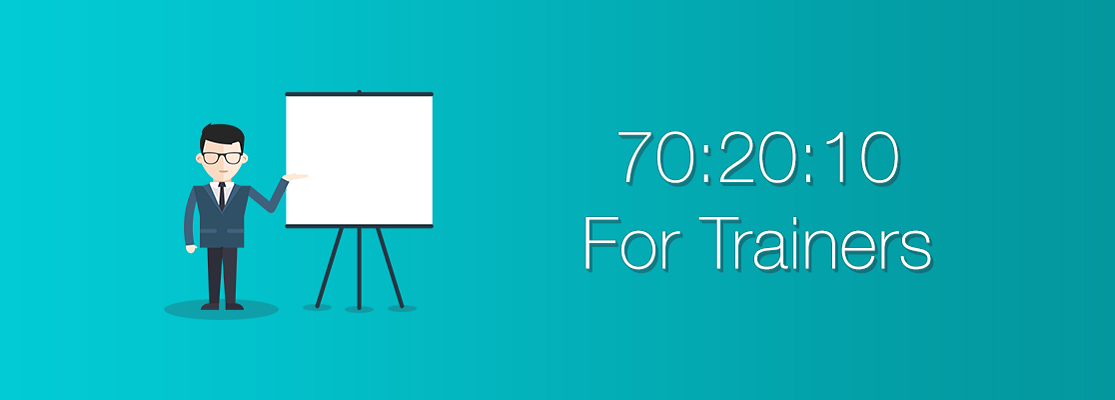70:20:10 FOR TRAINERS
Learning & Development Professional has been running a poll on the following question:
Is the 70:20:10 model still relevant today?
And I’m shocked by the results. At the time of writing this blog, over half the respondents have chosen “No”. Assuming they are all L&D professionals, the extrapolation means most of us don’t think the 70:20:10 model is relevant to our work.
But what does this really mean?
In LDP’s article The 70:20:10 model – how fair dinkum is it in 2015? – by the way, “fair dinkum” is Australian slang for “real” or “genuine” – Emeritus Professor David Boud says he doesn’t think there is proper evidence available for the effectiveness of the model.
If this is a backlash against the numbers, I urge us all to let it go already. Others have explained umpteen times that 70:20:10 is not a formula. It just refers to the general observation that the majority of learning in the workplace is done on the job, a substantial chunk is done by interacting with others, while a much smaller proportion is done off the job (eg in a classroom).
Indeed this observation doesn’t boast a wealth of empirical evidence to support it, although there is some – see here, here and here.
Nonetheless, I wonder if the hoo-ha is really about the evidence. After all, plenty of research can be cited to support the efficacy of on-the-job learning, social learning and formal training. To quibble over their relative proportions seems a bit pointless.
Consequently, some point the finger at trainers. These people are relics of a bygone era, clinging to the old paradigm because “that’s how we’ve always done it”. And while this might sound a bit harsh, it may contain a seed of truth. Change is hard, and no one wants their livelihood threatened.
If you feel deep down that you are one of the folks who views 70:20:10 as an “us vs them” proposition, I have two important messages that I wish to convey to you…1. TRAINING WILL NEVER DIE
While I believe the overall amount of formal training in the workplace will continue to decrease, it will never disappear altogether – principally for the reasons I’ve outlined in Let’s get rid of the instructors!.
Ergo, trainers will remain necessary for the foreseeable future.
2. THE 70:20:10 MODEL WILL IMPROVE YOUR EFFECTIVENESS
As the forgetting curve illustrates, no matter how brilliant your workshops are, they are likely to be ineffective on their own.To overcome this problem, I suggest using the 70:20:10 model as a lens through which you view your instructional design.
For example, suppose you are charged with training the sales team on a new product. As a trainer, you will smash the “10” with an informative and engaging workshop filled with handouts, scenarios, role plays, activities etc.
Then your trainees return to their desks, put the handouts in a drawer, and try to remember all the important information for as long as humanly possible.
To help your audience remember, why not provide them with reference content in a central location, such as on the corporate intranet or in a wiki. Then they can look it up just in time when they need it; for example, in the waiting room while visiting a client.
Job aids would also be useful, especially for skills-based information; for example, the sequence of key messages to convey in a client conversation.
To improve the effectiveness of your workshop even further, consider doing the following:
- Engage each trainee’s manager to act as their coach or mentor. Not only does this extend the learning experience, but it also bakes in accountability for the learning.
- Encourage the manager to engineer opportunities for the trainee to put their learning into practice. These can form part of the assessment.
- Set up a community of practice forum in which the trainee can ask questions in the moment. This fosters collaboration among the team and reduces the burden on the L&D department to respond to each and every request.
- Partner each trainee with a buddy to accompany them on their sales calls. The buddy can act as a role model and provide feedback to the trainee.
In my humble opinion, it is counter-productive to rail against 70:20:10.
As an L&D professional, it is in your interest to embrace it.
Written by our Guest Blogger, Ryan Tracey
Ryan Tracey is the E-Learning Manager at a well-known financial services organisation in Australia. He is also an Editorial Board Member for eLearn Magazine, a moderator for Lrnchat and a co-organiser of Third Place in Sydney.
Ryan has worked in corporate e-learning for over a decade, following several years in the higher education market. He holds a Master’s degree in Learning Sciences and Technology from the University of Sydney, is a regular contributor to industry magazines, and has won a bunch of training awards.
_________________________________
Copyright of posts written by our Guest Bloggers are their own.
Published on 21-Mar-2016






